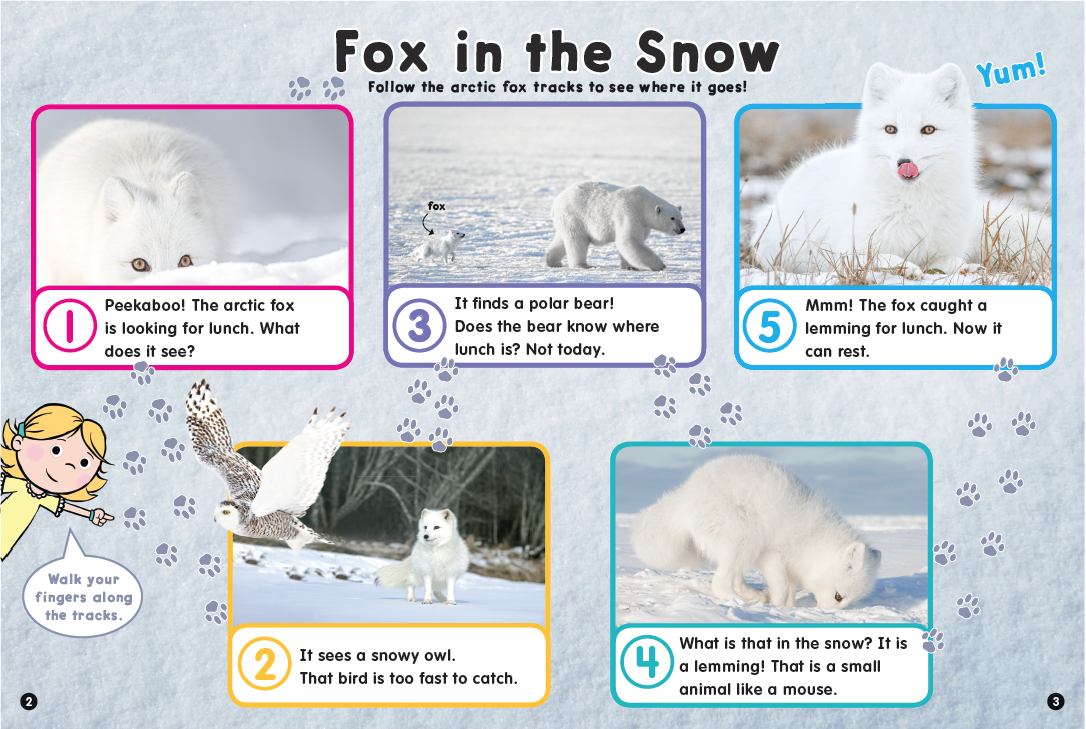
Exploring Animal Tracks with Pre-K
Outdoor winter walk, then indoor art and observation.
By Deborah J. Stewart
Grade: Pre-K
Source: My Big World
Key Takeways:
• Use My Big World’s “Follow the Fox” issue to kick off your own backyard study.
• Listen to your children’s discussions. What do they know? What would they like to learn more about?
• Invite your students to notice the details of real animals’ tracks in your back yard. Bring that learning back indoors.
In my classroom, we like to use My Big World magazine to kick off real-life studies. In this January issue of My Big World, the children are invited to “Follow the Fox.” As they follow fox tracks, they discover that the little white fox is looking for something to eat. After following the fox’s tracks in our magazine, we were then ready to head outside to see what animal tracks we might find in our own back yard. There are so many ways to explore real life right in your own back yard (or on your playground).

Go Outside and Look for Animal Tracks
The children found lots of squirrel tracks and people tracks. We also found a few tracks that were a mystery to us. “I think these might be a fox!” exclaimed one child. “I think they are deer tracks,” said another. The children tossed out their ideas and while they did, I was able to make note of what animals the children were already familiar with and what animals we could spend a little more time learning about.
Like the fox in My Big World, the children followed any tracks they found to see where they might lead. The children determined that the squirrels were hunting for food on the ground and maybe even up in the trees. They also wondered what the squirrels would eat should all the acorns get buried in snow or get all crunched up from people walking on them.
Back Inside, Make “Pretend Tracks” with Toy Animals and Paint
Back inside the classroom, we continued our exploration of animal tracks by using toy animals to make pretend tracks in paint. The children focused on making as many tracks as they could. They made their animals run across the paper and “step on” each other’s tracks.
Compare the “Pretend Tracks” to Photos of Real Animal Tracks
We also compared and contrasted the different shapes of our animal tracks with pictures of real animal tracks. We discovered that the tracks made by our pretend animals didn’t quite have all the same details of real animal tracks. But the shapes of the tracks were pretty close!
My Big World boosted the children’s interest in learning more about animals in the winter. There is so much to explore and discover! The best part is that whether there is snow on the ground or not, there is always the possibility that some little critter will be looking for food and leaving his tracks right outside in your own back yard.
Deborah J. Stewart has worked in early-childhood education for over 30 years. She runs a preschool for children ages 3–5 in Indiana. She also writes the blog teachpreschool.org.
Key Takeways:
• Use My Big World’s “Follow the Fox” issue to kick off your own backyard study.
• Listen to your children’s discussions. What do they know? What would they like to learn more about?
• Invite your students to notice the details of real animals’ tracks in your back yard. Bring that learning back indoors.
In my classroom, we like to use My Big World magazine to kick off real-life studies. In this January issue of My Big World, the children are invited to “Follow the Fox.” As they follow fox tracks, they discover that the little white fox is looking for something to eat. After following the fox’s tracks in our magazine, we were then ready to head outside to see what animal tracks we might find in our own back yard. There are so many ways to explore real life right in your own back yard (or on your playground).

Go Outside and Look for Animal Tracks
The children found lots of squirrel tracks and people tracks. We also found a few tracks that were a mystery to us. “I think these might be a fox!” exclaimed one child. “I think they are deer tracks,” said another. The children tossed out their ideas and while they did, I was able to make note of what animals the children were already familiar with and what animals we could spend a little more time learning about.
Like the fox in My Big World, the children followed any tracks they found to see where they might lead. The children determined that the squirrels were hunting for food on the ground and maybe even up in the trees. They also wondered what the squirrels would eat should all the acorns get buried in snow or get all crunched up from people walking on them.
Back Inside, Make “Pretend Tracks” with Toy Animals and Paint
Back inside the classroom, we continued our exploration of animal tracks by using toy animals to make pretend tracks in paint. The children focused on making as many tracks as they could. They made their animals run across the paper and “step on” each other’s tracks.
Compare the “Pretend Tracks” to Photos of Real Animal Tracks
We also compared and contrasted the different shapes of our animal tracks with pictures of real animal tracks. We discovered that the tracks made by our pretend animals didn’t quite have all the same details of real animal tracks. But the shapes of the tracks were pretty close!
My Big World boosted the children’s interest in learning more about animals in the winter. There is so much to explore and discover! The best part is that whether there is snow on the ground or not, there is always the possibility that some little critter will be looking for food and leaving his tracks right outside in your own back yard.
Deborah J. Stewart has worked in early-childhood education for over 30 years. She runs a preschool for children ages 3–5 in Indiana. She also writes the blog teachpreschool.org.
Key Takeways:
• Use My Big World’s “Follow the Fox” issue to kick off your own backyard study.
• Listen to your children’s discussions. What do they know? What would they like to learn more about?
• Invite your students to notice the details of real animals’ tracks in your back yard. Bring that learning back indoors.
In my classroom, we like to use My Big World magazine to kick off real-life studies. In this January issue of My Big World, the children are invited to “Follow the Fox.” As they follow fox tracks, they discover that the little white fox is looking for something to eat. After following the fox’s tracks in our magazine, we were then ready to head outside to see what animal tracks we might find in our own back yard. There are so many ways to explore real life right in your own back yard (or on your playground).

Go Outside and Look for Animal Tracks
The children found lots of squirrel tracks and people tracks. We also found a few tracks that were a mystery to us. “I think these might be a fox!” exclaimed one child. “I think they are deer tracks,” said another. The children tossed out their ideas and while they did, I was able to make note of what animals the children were already familiar with and what animals we could spend a little more time learning about.
Like the fox in My Big World, the children followed any tracks they found to see where they might lead. The children determined that the squirrels were hunting for food on the ground and maybe even up in the trees. They also wondered what the squirrels would eat should all the acorns get buried in snow or get all crunched up from people walking on them.
Back Inside, Make “Pretend Tracks” with Toy Animals and Paint
Back inside the classroom, we continued our exploration of animal tracks by using toy animals to make pretend tracks in paint. The children focused on making as many tracks as they could. They made their animals run across the paper and “step on” each other’s tracks.
Compare the “Pretend Tracks” to Photos of Real Animal Tracks
We also compared and contrasted the different shapes of our animal tracks with pictures of real animal tracks. We discovered that the tracks made by our pretend animals didn’t quite have all the same details of real animal tracks. But the shapes of the tracks were pretty close!
My Big World boosted the children’s interest in learning more about animals in the winter. There is so much to explore and discover! The best part is that whether there is snow on the ground or not, there is always the possibility that some little critter will be looking for food and leaving his tracks right outside in your own back yard.
Deborah J. Stewart has worked in early-childhood education for over 30 years. She runs a preschool for children ages 3–5 in Indiana. She also writes the blog teachpreschool.org.
